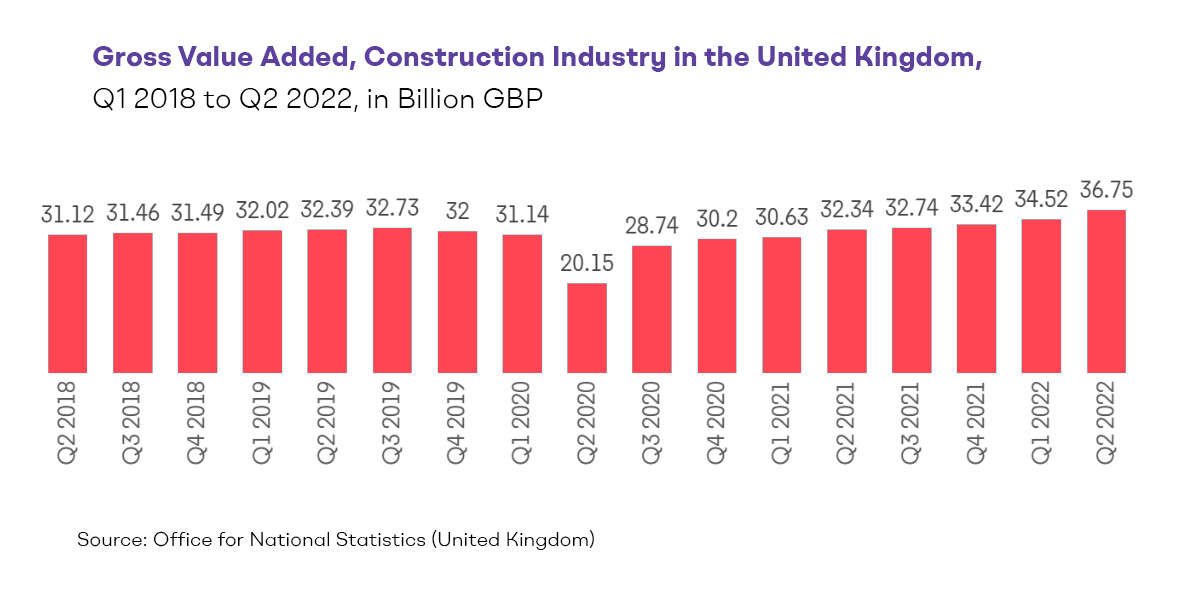
Are you ok with optional cookies ?
They let us give you a better experience, improve our products, and keep our costs down. We won't turn them on until you accept. Learn more in our cookie policy.

The construction sector in the United Kingdom is a thriving and dynamic environment that reflects the strength of the country's economy. Today, we set out on a quest to understand the present situation of construction in the UK. Our attention is firmly focused on current events, developing trends, and the critical variables dictating the direction of this dynamic sector.
The construction market was valued at an astounding $470.4 billion in 2022. This accomplishment is particularly amazing because of the challenging and uncertain environment in which it took place. The UK fabrication industry has danced through a complicated tapestry of difficulties, from the ups and downs of the economy to seismic worldwide events like the COVID-19 pandemic and inflationary pressures.
However, the UK fabrication market has shown amazing endurance in the face of hardship. As they skillfully navigated choppy waters, its participants demonstrated an unwavering spirit of flexibility and inventiveness, highlighting the sector's inherent strength.
The UK fabrication market is estimated at USD 386.36 billion in 2023, with projections indicating further growth to USD 452.15 billion by 2028, boasting a Compound Annual Growth Rate (CAGR) of 3.19% during the forecast period (2023-2028).
The UK fabrication industry is currently facing several key challenges:
Technology can play a significant role in addressing the challenges faced by the UK real estate industry. Here are some ways:
Despite these advantages, the construction sector has been slow to adopt digital technology. However, with the right approach and mindset, technology can indeed be a game-changer for the construction industry.
Despite these challenges, the UK's construction sector found areas of growth. Notably, civil engineering and commercial sectors experienced surges in new orders, driven by corporate demand and infrastructure projects.
The pandemic sent shockwaves through the construction industry in 2020, resulting in a steep decline. Nevertheless, the sector demonstrated remarkable resilience, achieving consistent growth in construction output every month since March 2021.
Key segments of the construction industry witnessed significant shifts. Private housing emerged as a dominant force, while housing and non-housing repair and maintenance contributed substantially to construction output. Infrastructure construction exhibited the highest market share growth in the sector.

The UK real estate industry is evolving with several noteworthy trends:
Sustainable real estate Solutions: Eco-friendly materials and energy-efficient designs are gaining prominence to meet environmental regulations.
Technological Advancements: Building Information Modeling (BIM), automation, and drones enhance project efficiency, accuracy, and safety.
Modular and Prefabricated Construction: These methods reduce waste and disruption while speeding up project delivery.
Infrastructure Investment: Government projects such as High-Speed 2 (HS2) and Heathrow Expansion drive real estate growth.
Digital Transformation: Digital tools improve project management, collaboration, and data analysis, enhancing decision-making.
Resilience Planning: Designs now incorporate flexibility to cope with unforeseen disruptions, highlighting the importance of resilience.
Workforce Development: Training and upskilling programs address the skilled labor shortage.
Health and Safety: Enhanced safety protocols prioritize worker well-being and minimize accidents.
Affordable Housing Initiatives: Initiatives aim to address the affordable housing shortage, driving growth in this sector.
Post-Pandemic Realignment: Remote work impacts the design and real estate of commercial and residential properties.
Also, in the second quarter of 2022, the UK real estate sector's gross value added (GVA) was more than four billion British pounds greater than in 2021, according to the Office for National Statistics.

Projections indicate an Average Annual Growth Rate (AAGR) of over 2% from 2024 to 2027, underscoring the real estate sector's potential for sustained growth. This growth not only reflects the industry's resilience but also its ability to seize opportunities, adapt to changing circumstances, and innovate in response to evolving market dynamics.
The UK real estate industry has proven itself to be not just dynamic but remarkably resilient in the face of adversity. It has weathered economic fluctuations, global crises, and uncertainties, emerging stronger and more adaptable. With a promising outlook characterised by sustained growth projections and a commitment to innovation and sustainability, this sector remains a cornerstone of the country's economic landscape. As it navigates the ever-changing dynamics of the industry, embracing technological advancements, sustainability initiatives, and workforce development, the UK real estate industry continues to build the future, one brick at a time.